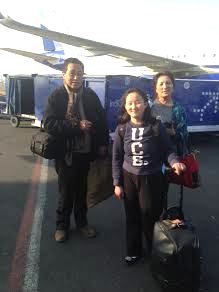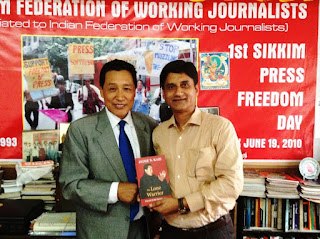Hermons On The
Mount
My alma mater, Mount
Hermon School (MHS,
often referred to as MH), Darjeeling,
did not start with a bang. For Miss Emma Knowles, a Christian missionary from
the US, who founded Queen’s Hill School
in Darjeeling
way back in the latter part of the 19th century, it was an uphill
task. Funds were low and competent and dedicated teachers were even more scarce.
MH was first called ‘Arcadia’ when it was first established in a
bungalow below Chowrasta facing Lebong in 1895. Three years after its founding
a massive earthquake in 1898 killed thirteen of its students when the school
building collapsed. Failures did not deter Knowles. She had faith in God
Almighty to provide for all her needs.
A few years later, Knowles shifted the
location of the school to below Mt. Everest Hotel near the railway station and
renamed the school – Queen’s Hill School (QHS). In the turn of the 20th
century, QHS (the old schools buildings are still there) shifted to the present
location below Singamari. The school was expanding and needed more space. It
was again renamed Mt.
Hermon School
in 1929. The present MH campus originally had 100 acres. It has now only about
80 acres. The rest is history.
I have great love, affection and regard for
my alma mater. Even after nearly three decades since leaving MH my
passion for the school has not diminished. MH not only gave me a sound
educational foundation but also gave me the much-needed training and experience
to become a qualified teacher. What MH taught me has withstood the test of
time. And that is why I recently dedicated my second book, “Sikkim For
Sikkimese” to “My teachers who taught me how to read and write and aim for
higher things in life.”
Hermonites:
We Hermonities are a peculiar breed. Commented a Northpointer, who at times get
invited to our ‘reunions’: “Your get-togethers are very different and informal.
I enjoy it. We get stuck in protocols.” My reaction to this has been: “We are
Protestants, you chaps follow the Jesuit Order. We are comfortable with
disorder!”
When Hermonite NK Pradhan was
recently inducted into the Chamling Cabinet as Human Resources Devlopment (HRD)
Minister it was time to party again. “NK” (Senior Cambridge 1968), fourth time
winner of the Assembly elections, during our get-together in Hotel Tashi Delek
(one of our favourite haunts) rightly acknowledged, “We Hermonites should feel
proud that we have many Hermonites in high places.”
One of the oldest active members of the
Sikkim Hermonites Association (SHA), formed in 1983, is former Secretary, Tashi
Densapa, who is presently the Director of the world-renowned Namgyal Institute
of Tibetology (NIT), which is one of the three such institutions in the world
for study and research on Tibetology and the Himalayan region.
Hermonites, by and large, are a versatile
lot. Our definition of “high places” is not confined to “government service.”
Even on this count we have several big shots. Our Association’s President,
Karma Bhutia (Senior Cambridge ’72), is Principal Secretary and Chief Engineer.
Senior Hermonite Nim Lhamu Ethenpa is also a Secretary and another senior
Hermonite Tempo Bhutia is not only the Managing Director of SITCO but also the
President of the Sikkim Football Association. And the list could go on and on…
Besides myself, one of the Hermonites who
has been giving a tough time to the establishment is Athup Lepcha, former
Minister who now heads the Affected Citizens of Teesta (ACT) as its President.
The ACT is against big hydel projects in the Dzongu region of North Sikkim,
largely inhabited by the Lepchas, widely regarded as the original inhabitants
of Sikkim.
The Lepchas are now a fast-vanishing tribe and a prominent Hermonite is leading
the movement fighting for their survival in the land of their origin.
Karma Bhutia rightly noted during the
dinner hosted by the Hermonites to felicitate “NK”: “Where in Sikkim would
you find a member of the Opposition like Jigme enjoying the company of a
Cabinet member of the ruling party?” Even if others don’t follow our example we
still need to set the right trend.
“NK daju” must recall the
times he used to lead groups in singing patriotic songs during Independence Day
(August 15) functions in MH. The song sung in Hindi went like this: “Insafki
dagarape /Bacho dekhao chalke/Ye desh hai hamara/Neta tume ho kala ke”
(the song exhorts children, who are the future leaders, to tread the path of
justice)
Now that “NK” himself has become a pucca
neta he must try to always tread the path of justice. We, particularly the
Hermonities, will judge “NK” not only by his loyalty to his government, party
leadership, and the people but by his commitment to ideals and principles that
give birth to great institutions and nations. What is the use of our unique
educational background and experience if we cannot set high standards in public
life?
White House connection: Luckily, Hermonites now have a live connection with the most
powerful man on earth – the US
President, Barack Hermonite Obama! Only last week Obama appointed Hermonite
Barbara Nichols-Roy’s South Indian husband (now
settled in the US), Vinai K.
Thummalapally, as the US
Ambassador to the small Central American country of Belize. (see page 1 for details).
The Nichols-Roys, originally from Shillong,
are known to most Hermonites of the ’60s, ’70s and ’80s. “NK” is familiar with
Marian Nichols-Roy, the eldest daughter of Stanley and Helen Nichols-Roy.
For Barbara and Vinai, Obama is not only
their former college classmate but they also helped to raise funds and
campaigned for him.
Says Barbara,“We are very honoured and
privileged, proud and humbled, all at the same time, to have been a part of it
and to know that we played a part in Obama's historic success.”
Vinai’s appointement naturally gave an
opportunity for global Hermonites to get in touch with each other. I’ve already
congratulated Vinai and Barbara on behalf of Sikkim Hermonites and Hermonite
International (Hi!) and also hinted for a global Hermonites’ meet at Belize to which
she replied, “Thank you, Jigme.”
Press freedom: Earlier this week, I met one of my former colleagues in the media
who participated in the historic rally for Press Freedom in Gangtok on June 19,
1993. We were supposed to meet again and chalk out a plan to strengthen Press
Freedom in Sikkim.
He did not turn up. Therefore, I take upon myself to strengthen our resolve and
float a body known as “Sikkim Press Freedom Forum” (SPFF) on this special day –
June 19, 2009 to mark the 16th anniversary of our rally. If the
opportunity comes we hope to observe June 19 each year as Sikkim Press Freedom
Day.
This body ought to have been formed last
year when several journalists belonging to Hamro Prajashakti, an
independent Nepali daily, were brutally assaulted by unknown assailants at
their work place. Though my advice went unheeded the need to safeguard Press
freedom in our Sikkim
still persists.
My message and statement issued during the
rally on June 19, 1993, which was carried in my book, “Inside Sikkim:
Against the Tide” (released at the Press Club of India in New Delhi in
December 1993 by former External Affairs Minister, K Natwar Singh, and launched
in Sikkim in February 1994 by Pawan Chamling, the present Chief Minister of
Sikkim) is still relevant:
“Let me remind you today that media-persons
and media organizations cannot alone ensure and protect the freedom of the
Press. In the final analysis, it is the people who have to come forward and
provide the much-needed protection to journalists and safeguard freedom of the
Press.
But we, as journalists, must make our stand
very clear. We must stand firm and resolute in our stand. While our opinions as
journalists my differ on various issues and matters, we cannot and must not
allow vested interests or our own selfish motives to creep in and deprive us of
the opportunity to stand erect and united on the issue of the Freedom of the
Press. It is not how many of us are here today to support the cause of the
Freedom of the Press that matters, but how much faith, sincerity and dedication
that we have in the righteousness of our cause.”
Free Suu Kyi: June 19, 2009 also marks the Burmese leader Aung San Suu Kyi’s 64th
birth anniversary. Though her National League for Democracy (NLD) won the 1990
general elections in Burma
the military junta unjustly put her under house arrest. The pro-democracy
leader has already spent 13 of her last 19 years under house arrest.
Barack Obama recently called for Suu Kyi’s
“immediate and unconditional” release even as several world leaders mounted
pressure for her early release. We, too, join them in their endeavour to seek
her early release. In fact, only last week I floated the formation of a global
body – “International League for Democracy” (ILD) – to pressure the
authorities for Suu Kyi’s early release through the pages of this paper. I’m
hopeful and positive that the Hermonites will turn this solo into a chorus till
the world community takes notice and forces democracy and justice to prevail in
Burma.
My last week’s appeal on the Burmese leader
read: “Sikkim Observer joins freedom-loving individuals and
organizations throughout the world in celebrating the birth anniversary of this
gentle rebel and urges everyone to put more pressure on the authorities for her
early release. It proposes formation of International League for Democracy
(ILD) to achieve this objective and to fight for freedom and democracy for all
people all over the world and at all times.”
Change has indeed come to America; change must also come to Burma. India’s future Prime Minister, Rahul Gandhi,
(for June 19th is his birthday, too), must know that India’s Look East policy will remain a distant
dream if the situation in Burma
continues to remain unchanged. Moreover, India must regain her rightful
place in the world community and exert her moral authority on bigger issues
such as freedom and democracy.
The voice that spoke these words in her
famous “Freedom From Fear” speech must not be silenced forever: “It is not
power that corrupts but fear. Fear of losing power corrupts those who wield it
and fear of the scourge of power corrupts those who are subject to it.”
How true are these words in our situation
in Sikkim
in the past so many decades.
(This
is an article by Jigme N Kazi in his Sikkim Observer in May-June 2009)



































